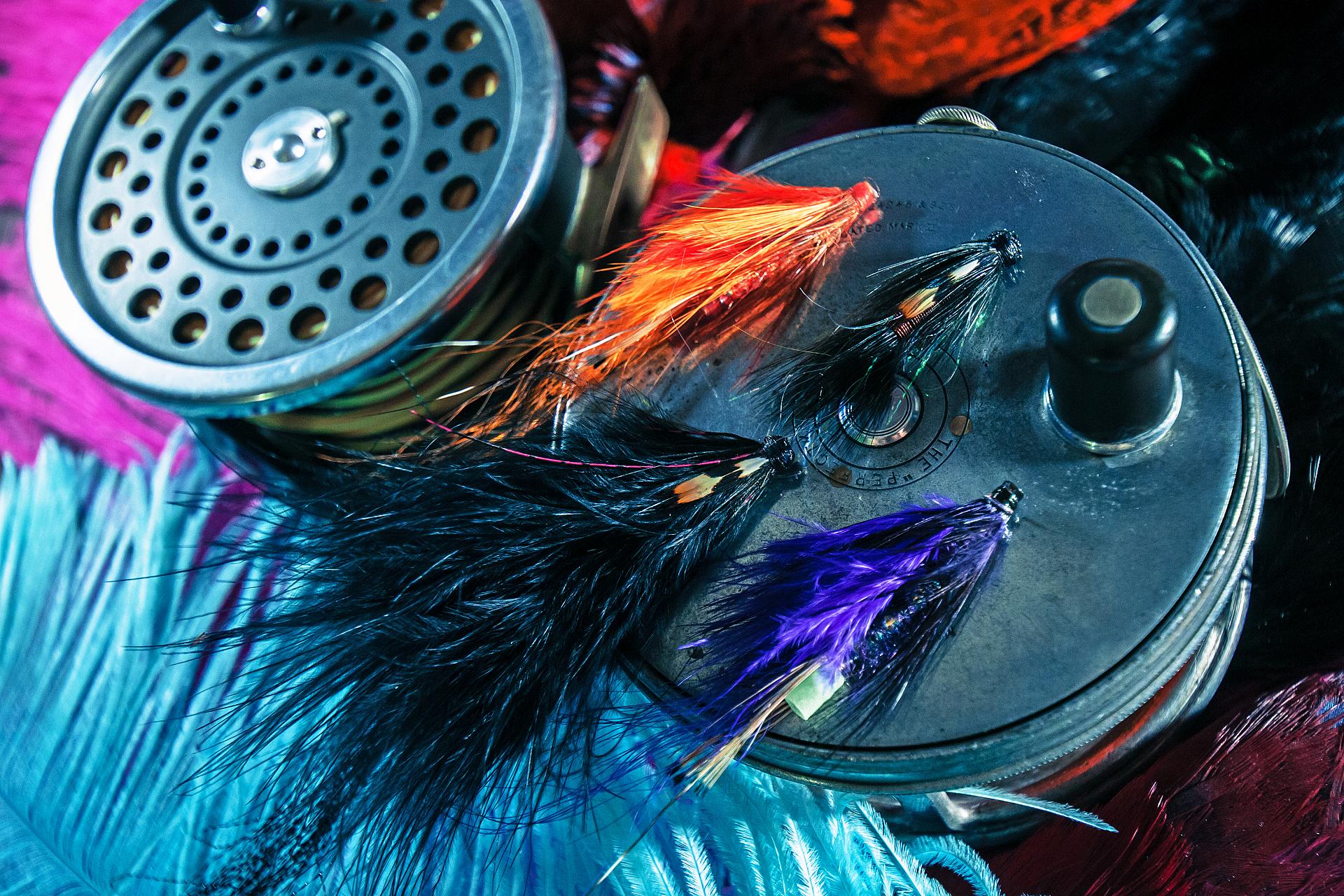British Columbia’s storied waters are among steelheading’s most hallowed. Names like the Dean, Kispiox, and Bulkley are whispered with reverence internationally, and for many, a steelheader’s life is not complete without at least one visit to them all.
Advertisement
I’m often asked by visiting anglers which flies they should bring, and I always encourage them to bring along the ones they believe in, and fish them with confidence. I tend to think that steelhead success is more about keeping a good fly in good water than it is about having the right fly. Still, there are fly styles and patterns that I turn to year after year, and that I recommend—and that I’ve heard recommended by anglers familiar with our great waters.
Steelhead are not known for a having particularly refined palates. They are not demanding gourmets. In river they’ll chase and occasionally eat bugs, little fish, cigarette butts, roe, and shoelaces with hooks tied to them. Unlike resident trout that sometimes need you to put some effort into fooling them, unhassled steelhead will bite pretty much anything–or nothing at all. While the theories abound as to why steelhead do or don’t take flies, after twenty-two years swinging flies in steelhead water I’ve accepted that I’ll never really know why, I’m just lucky that they do.
Advertisement
So here is my unabashedly biased look at a small sampling of BC’s Best Steelhead Flies. I’ve collected these patterns under four broad categories of flies that consistently take BC steelhead: Steelhead Prawn wet flies; Intruders and Leechy-Squiddy looking wet flies; “Buggy” wet flies; and Skaters. Here you’ll find offerings you can fish deep or skate along the surface. You can tie them in different sizes, and alter them to make them your own. They all work, and they all work very well.
I came to steelhead from a trout background, so to me a fly really isn’t a fly unless it at least kind of looks like something a fish might really like to eat, as opposed to something that might simply annoy it into biting. So among these flies you’ll find patterns that—at least to me—look like steelhead food. But I can also accept that the Raging Prawn might not look at all yummy to a steelhead–it might just be irritating.
Advertisement
Some of these flies are “BC originals”; others have been adapted from classic Atlantic salmon patterns; and some have been introduced to our waters by enthusiastic international anglers. Each represents a creative solution to the problem of getting steelhead to rise to a fly.
Admittedly, most of these flies are a bit fiddly to tie. This is by design. Steelhead are the coolest, most rugged, noble and badass fish you can catch in freshwater. Orcas chase them around, seals take bites out of them, nets rip their gill plates off, and they get bashed around ascending throat-tightening rapids and sometimes waterfalls. Despite this—or perhaps because of it– when you hook them, they give you 100%. Always. And though steelhead might not be too demanding of us, we need to be demanding of ourselves when we angle for them, for we dishonour their spirit–and our own—when we fail to put thought and effort into the patterns we tie and present to them.
Steelhead Prawns
The General Practitioner—or “GP”—was originally developed as an Atlantic salmon fly by Colonel Esmond Drury in response to a ban on natural prawns as bait on British salmon rivers. This fly and its prawn-like derivatives have been responsible for many, many memorable days, including my largest steelhead to date, a 41-inch Thompson doe. GPs work in all steelhead waters, winter or summer, so they are a great pattern to build a fly box around. Fished on a floating line in the fall, or a sink tip in the winter, the GP will always produce when steelhead are inclined to move to a fly.
Raging Prawn
Former world champion Spey caster Tyler Kushnir ties an excellent tube fly variation of the GP he calls the Raging Prawn. A distinguishing feature of this fly is Kushnir’s use of peccary hair as the “feelers” that contribute to the fly’s tail. Kushnir uses short shank straight eye bait hooks such as the Partridge Nordic Single in sizes 4 and 6 for all his tube fly patterns, held in place by inserting the hook eye into a short length of soft plastic tubing at the back of the fly. This is a deadly pattern that I fish with confidence winter or summer, rain or shine, often right through the day in all water types.
Tube: Black 1/8″ o.d. air brake tubing
Hook Holder: soft orange tubing slid over the rear of the air brake line and secured with tying thread
Thread: Orange 6/0
Tail: Orange bucktail or polar bear under golden pheasant tippet, 1 1/2 times longer than the tube
Antennae (“Feelers”): Natural peccary
Body: Orange imitation seal dubbing
Rib: Medium pearlescent Mylar
Wing: Alternating fluorescent orange and fire orange woolly bugger marabou starting about 1/3 of the tube’s length from the front
Hackle: A few turns of natural pheasant rump
Eyes (optional): Jungle cock nails
Aaron’s BC Orange Prawn
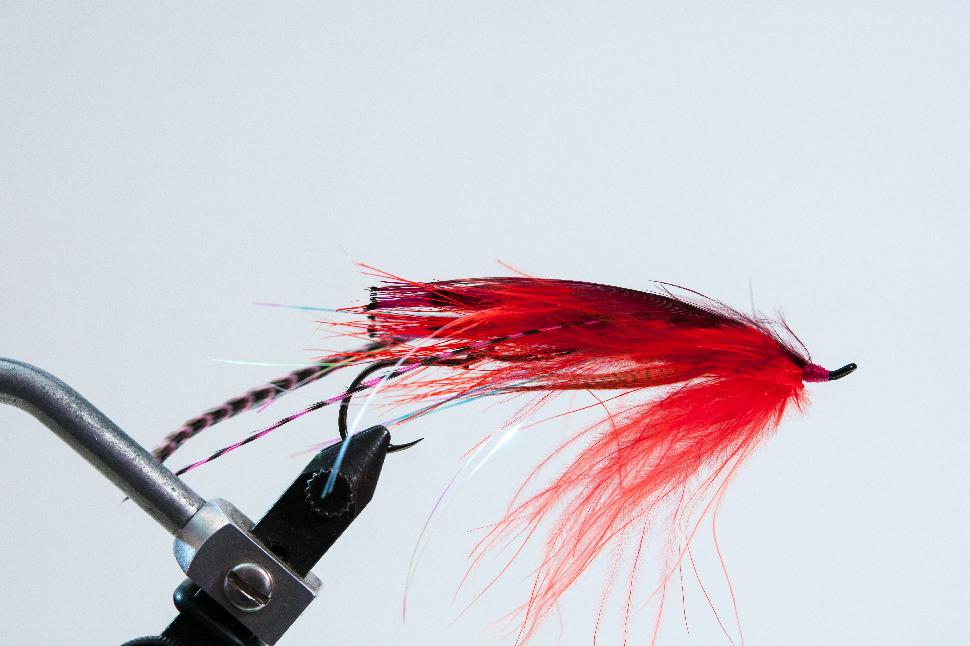
Aaron Goodis has established himself as one of BC’s pre-eminent outdoor photographers, and he’s also a heck of a fine angler and tyer. The BC Orange Prawn is a pattern that he often knots on. I asked him about its origins and his preferred presentation strategy:
“The BC Orange Prawn came from the old BC Orange gooey bob that was and still is heavily used in float fishing for winter steelhead. I think the colour is the main feature, and dressing it in a classic prawn style gives the fly class. It’s fished on a tight line swing on both sink tip and floating lines.”
Hook: Mustad SL53UBL #1/0
Trailing Hook: Owner #2
Trailing Wire: 50 lb fire line
Thread: pink 6/0
Tail: Orange Polar Bear, Pearl Flashabou, Pink Golden Pheasant tippets
Body: Orange Diamond braid, Orange mallard, Orange cactus chenille, Orange marabou
Wing: Pink grizzly hackle tips, Red golden pheasant skin
Squamish Poacher
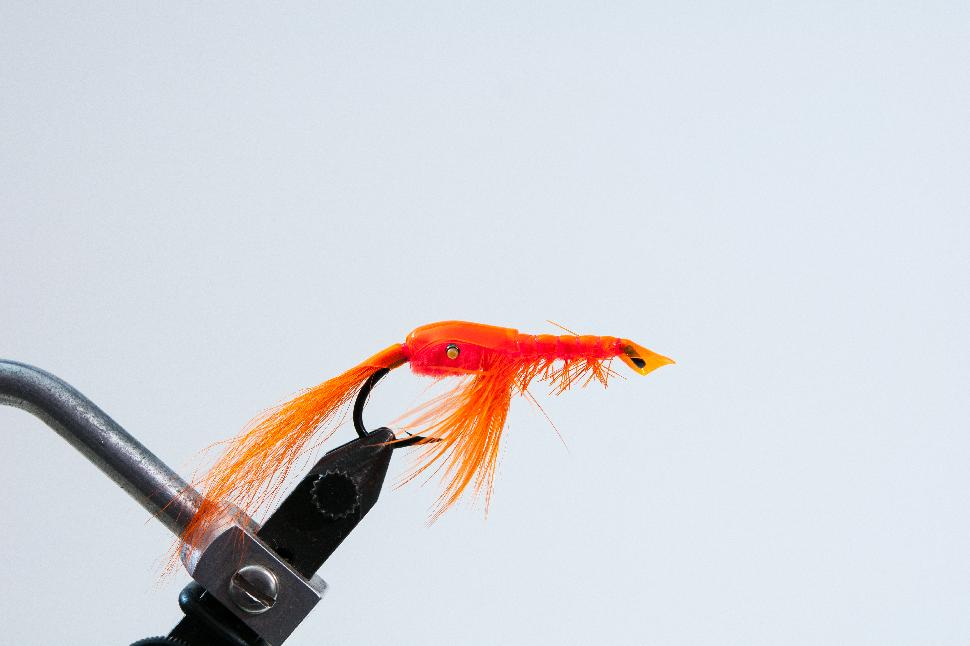
I don’t use the Poacher much, but I love this fly because it’s both a BC original and an example of the iconoclastic culture that has grown up in steelheading circles. Joe Kambietz is a gifted silversmith and carver, and originated this prawn fly for winter steelhead, but it works everywhere, and is a pattern that continues to remind those of us tweed cap types (including me) that sometimes we tend to take things a little too seriously.
Hook: Size 1 – 4 Mustad 7957BX
Thread: Orange monocord
Feelers: mixed hot orange and red bucktail, with a few strand of pearl flash
Body: fluorescent hot orange chenille large diameter
Legs: hot orange saddle hackle
Eyes: clear green beads epoxied to 15 pound mono
Carapace: fluorescent orange surveyor’s tape
Rib: silver or copper wire
Intruders and Leechy-Squiddy Looking Things
Intruders and Leech patterns often prove irresistible to steelhead. Intruders were originally tied and popularized by American angler Ed Ward during the last of the glory years of Skagit River winter steelheading in Washington State. Leeches have been around forever of course, and in larger sizes are great first light and last light patterns.
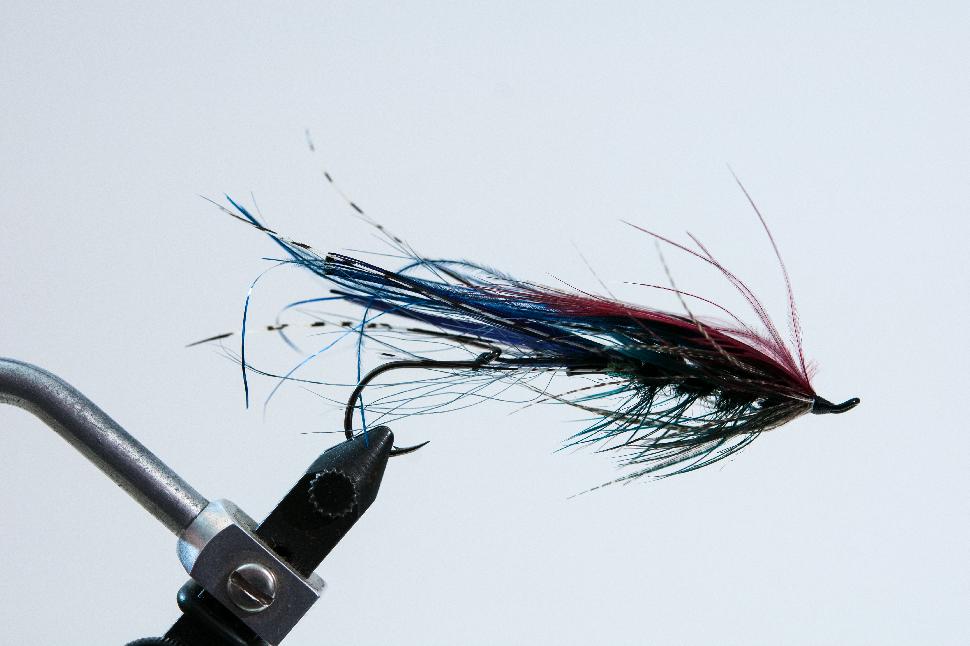
Aaron Goodis’s Intruder-style Steelhead GP is a creative blending of modern Intruder steelhead design and a classic BC pattern. The fly was developed for the Dean and Thompson Rivers, and is based on Art Lingren’s classic Black GP. According to Aaron, “I’ve always loved the Black GP and black classic flies for steelhead and this fly has been very successful over the years. The leechy look sets the fly off when fished on both sink tip and floating fly lines with a tight line swing. “
Hook: Mustad SL53UBL #1/0
Trailing Hook: Owner #2
Trailing Wire: 50 lb fire line
Thread: black 6/0
Tail: black polar bear, blue holographic tinsel, blue rhea, purple golden pheasant tips, natural Amherst tail fibres
Tag: green holographic tinsel
Body: black teal
Rib: silver oval tinsel
Hackle: blue schlappen
Collar: natural teal
Wing: Red Golden Pheasant
Voodoo Child
Tyler Kushnir’s Voodoo Child is the black or black and purple version of the Raging Prawn. Like Goodis’s Steelhead GP, the Voodoo has its origins in Art Lingren’s Black GP, as well as flies tied by American anglers Sean Gallagher and Dec Hogan. When tied in black and blue, I’ve also had great success with this fly on the Skeena system.
Tube: Black 1/8″ o.d. air brake tube
Hook Holder: soft fluorescent green tubing slid over the rear of the air brake line and secured with tying thread
Thread: Black 6/0
Tail: Black bucktail or polar bear under golden pheasant tippet, 1 1/2 times longer than the tube
Antennae: Natural peccary
Body: Black imitation seal dubbing
Rib: Medium pearlescent Mylar
Wing: Alternating black and purple woolly bugger marabou starting about 1/3 of the tube’s length from the front
Hackle: A few turns of black pheasant rump
Eyes (Optional): Jungle cock nails
Kilowatt
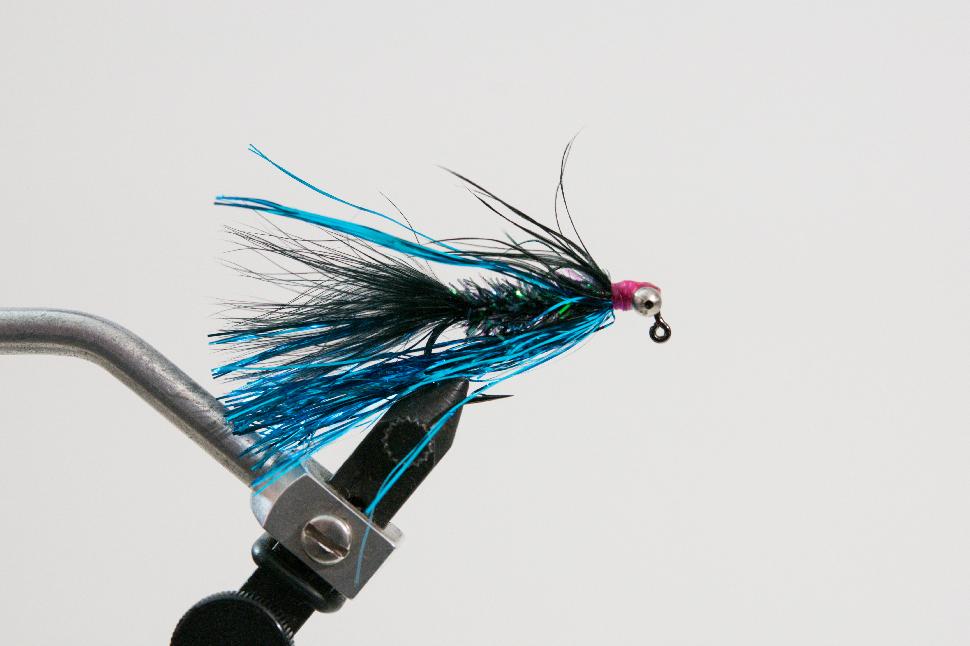
Brian Braidwood is the youthful president of the Steelhead Society of BC. A fearless and vocal advocate for wild steelhead, Brian leaves little doubt that the future of our sport and the fish we treasure is in good hands. Over coffee at Searun Fly and Tackle one day I asked Brian about BC’s Best Steelhead Flies. He reached for a few, but made particular note of the Kilowatt. “You have to include this one” he said. “It’s killer on the Skeena.”
The Kilowatt is the brainchild of American angler Cliff Watts, who has been fishing the Skeena system for nearly three decades. Years ago Watts discovered that a steelhead fly tied on jig hook with flashy materials in black and blue was virtually snag free and irresistible to northern steelhead. His pattern has become a BC standard.
Hook: Gamakatsu #60411-1/0 (Heavy Wire or HW)
Tail: black marabou
Wing: electric blue flashabou
Body: Opal Black Estaz
Ribbing: Black schlappen
Eyes: barbell or bead chain, 5/32, 3/16, or 7/32
“Buggy” Flies
BC’s steelhead fly fishers have long used “buggy” looking flies for steelhead, and for good reason: as juveniles in fresh water, steelhead eat the same sort of food items as resident rainbows, and mayfly, stonefly and caddis fly nymphs are often on the menu. Now, not all buggy looking flies are designed to suggest insect life, but they fit the bill as something anglers believe a steelhead might grab as reminiscent of today’s blue plate special.
Lady Caroline
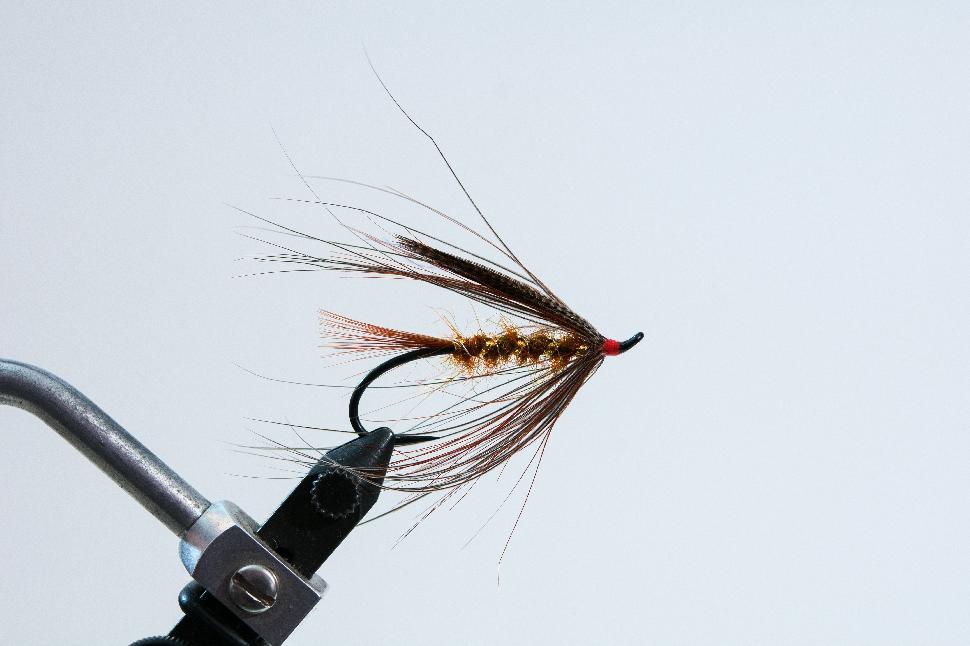
Poul Bech is a longtime member of the executive of the Steelhead Society of BC, and his contributions to steelhead conservation have earned him the Society’s prestigious Cal Woods award. He is one of BC’s most knowledgeable and experienced steelheaders. The Lady Caroline is the fly I see knotted on his leader more than any other. Bech ties the Caroline in various sizes and in slightly different shades depending on water and light conditions. He fishes this fly on a floating line with a long leader.
Hook: size 2/0 – 6 Tiemco 7999
Thread: black or flame 8/0
Tail: reddish golden pheasant breast
Body: mixed medium-olive and orange seal
Rib: flat gold and silver wire
Hackle: sparse stripped heron from second turn of wire
Throat: reddish golden pheasant breast
Wing: natural brown barred mallard flank, folded and on edge
Horns: pearlescent Krystal flash
Thompson Stone
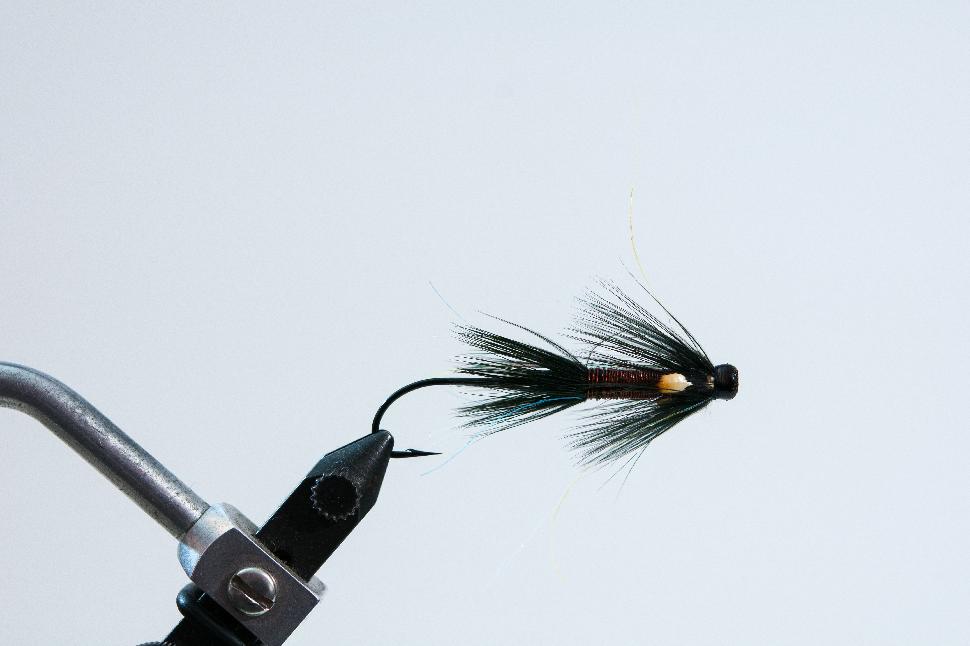
I developed the Thompson Stone as a tube fly to represent the abundant golden stonefly nymphs found in the Thompson River, but Poul Bech has noted that the fly also resembles the October Caddis Pupa. The original lacks the strands of flash and jungle cock eyes of the improved version, but both versions often produce for me when other flies have gone cold. Tied “in-the-round” a la Charles Brooks, the T-Stone has been responsible for numerous Thompson fish, including a memorable 38-inch screamer that ripped me up in the waters near Spences Bridge before coming to hand. It has also brought success on the Dean and Skeena systems. My hook of choice for these and other tube flies is the Daiichi 2451 in sizes 4 and 6.
Tube: Black 1/8″ o.d. air brake tube no longer than 1 1/4″
Hook Holder: none. Hook eye is inserted directly into the rear of the tube
Thread: Black 6/0
Rear Hackle: Black saddle covering 1/3 the length of the tube
Body: Medium copper or brown wire
Front Hackle: Black saddle covering 1/3 to ½ the length of the tube
Accents: A few strands of thin pearl flash
Eyes: Jungle cock nails (optional)
Skaters
The October Caddis is a common sight on autumn steelhead waters. And in the spring, stonefly adults can often be found along the rivers steelhead call home. As a result, juvenile steelhead have gotten used to seeing—and eating—bugs on the surface, so it makes sense that a fly skating along the top would attract an adult steelhead’s attention and result in some of steelheading’s most exciting moments.
Steelhead take skated flies in a variety of ways. Sometimes the take is explosive, like a large rock being hurled into the river. At other times the quickly moving fish leaves a large hole in the water as it grabs the fly and quickly returns to its lie. But my favourite take is when a steelhead simply eats the fly, just like a giant resident rainbow. The fly is skating along under tension, then the head of the fish appears as it sips in the fly. In my experience these are the most difficult fish to hook, because the natural reaction is to set quickly when the big head appears. But the best hookups are those resulting when the angler is so stunned by the rise that (s)he does nothing, and as the steelhead returns to its lie the line tightens and the fish is suddenly on.
Grantham’s Sedge
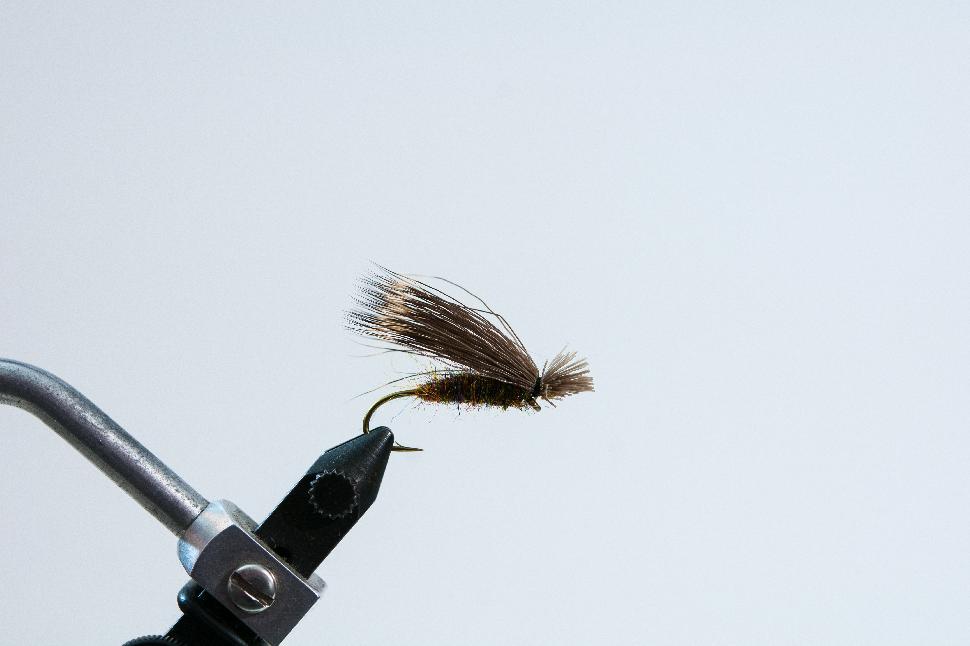
Ron Grantham is a long time member of the Totem Fly Fishers and builder of beautiful cane rods which he fishes with classic Hardy reels. Each fall Ron puts up enviable dry fly numbers on the Bulkley and Thompson. The fly? Grantham’s Sedge, of course!
Hook: Mustad 7958B, #6
Thread: brown
Body: brown dubbing over a length of .065” nylon line (the kind used for Weedeater-type lawn edgers). Make sure the nylon extends 1/8” beyond hook eye
Wing: deer hair, tied on the nylon line in front of the hook eye
Lambroughton Moose Hair Skater
The lodge and clubhouse at BC West feature several stunning photographs of the Dean River and related subjects. Year after year, one in particular always draws my eye—what looks like a jumble of steelhead dry flies artistically rendered. These are the Moose Hair Skaters, and I asked pattern creator—celebrated outdoor photographer David Lambroughton—to tell me about the fly:
“I started tying the Moose Hair Skater as I was looking for a smaller fly that would both go through the air easier than something like a Waller Waker and still be able to really push and plow the water. I’ve tried them in different sizes but a size 6 on a Tiemco 105 Hook is perfect. It’s been a very popular pattern with my sticky fingered friends and there’s something a bit more organic about it over the foam rubber and rubber leg creations that the fans of Classic Flies often stray away from. It’s also a very enjoyable pattern to tie.”
Hook: size 4 – 8 Tiemco 105
Thread: red flat waxed nylon
Tail: Moose hair
Body: chenille or dubbing (Lambroughton prefers orange Ice dubbing)
Back: Moose hair
Side Wing: Moose hair stubs
Wing: Moose hair
